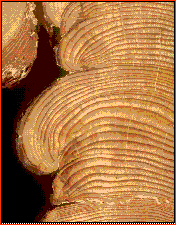 |
 |

|
Into Living Things If you were going to study El Niño, how would you do it? Maybe fly a
plane into a storm to collect data, study satellite records for sea surface
temperatures, or use buoys to measure sea surface winds? Those are all good
choices—and reflect what some scientists are doing now—to help researchers
understand what's going on with El Niño today.
If you were going to study El Niño, how would you do it? Maybe fly a
plane into a storm to collect data, study satellite records for sea surface
temperatures, or use buoys to measure sea surface winds? Those are all good
choices—and reflect what some scientists are doing now—to help researchers
understand what's going on with El Niño today.But how about using living things—like trees and coral reefs—and everyday occurrences—like snowfalls—to look at what's happened in past climates in order to understand what's happening today, or what might happen in the future? Scientists who do this call themselves paleoclimatologists. Check out some of the things they study and what they can learn: References Photo: © T.W. Swetnam and A.C. Caprio Anatomy of El Niño | Chasing El Niño | El Niño's Reach Dispatches | Resources | Mail | Site Map | El Niño Home Editor's Picks | Previous Sites | Join Us/E-mail | TV/Web Schedule About NOVA | Teachers | Site Map | Shop | Jobs | Search | To print PBS Online | NOVA Online | WGBH © | Updated November 2000 |